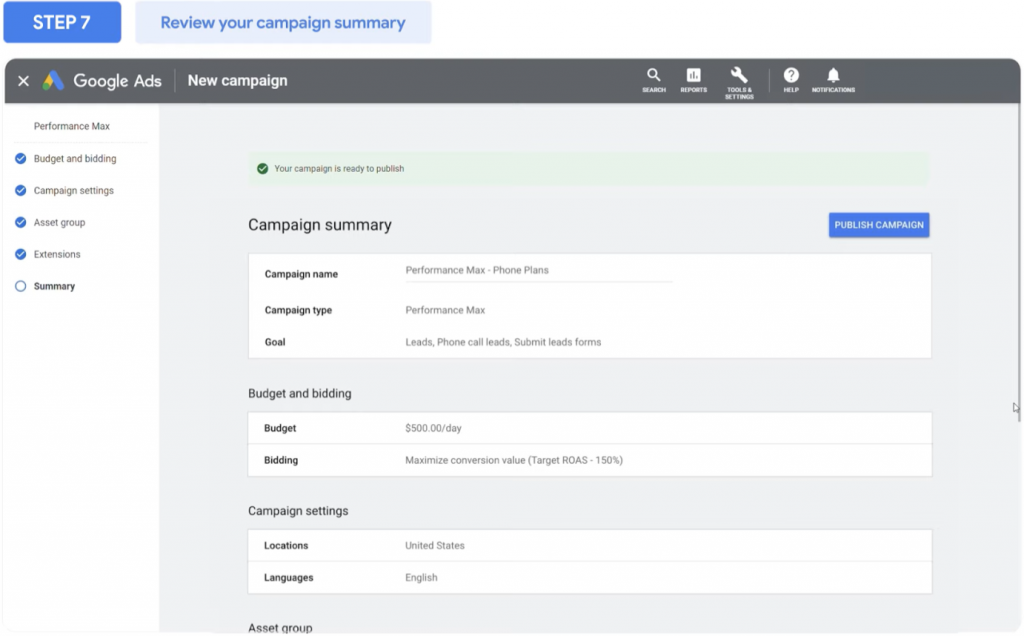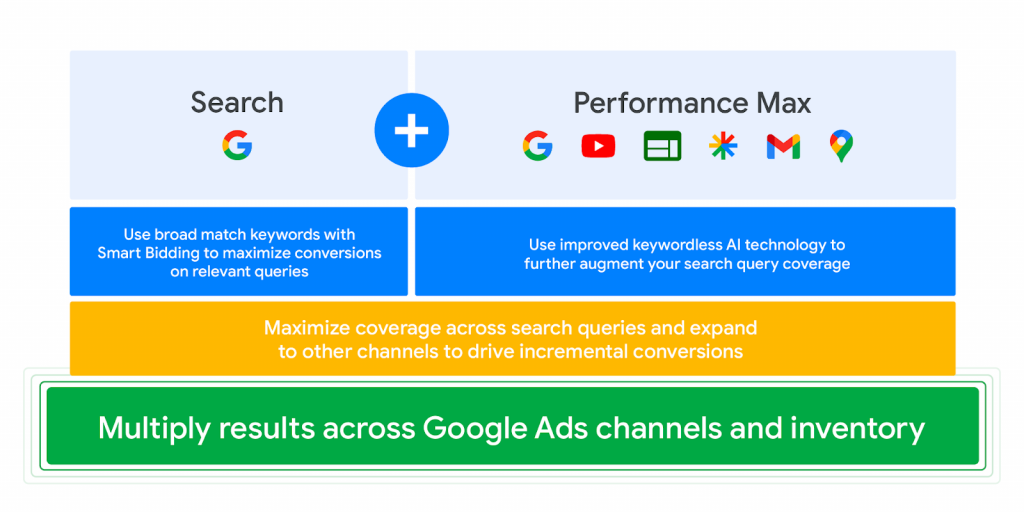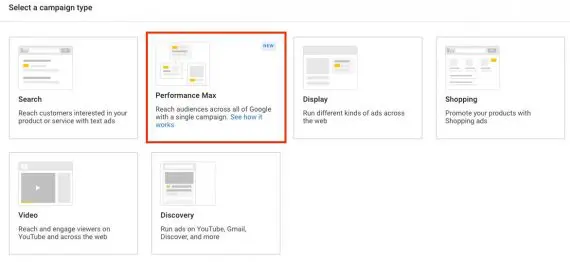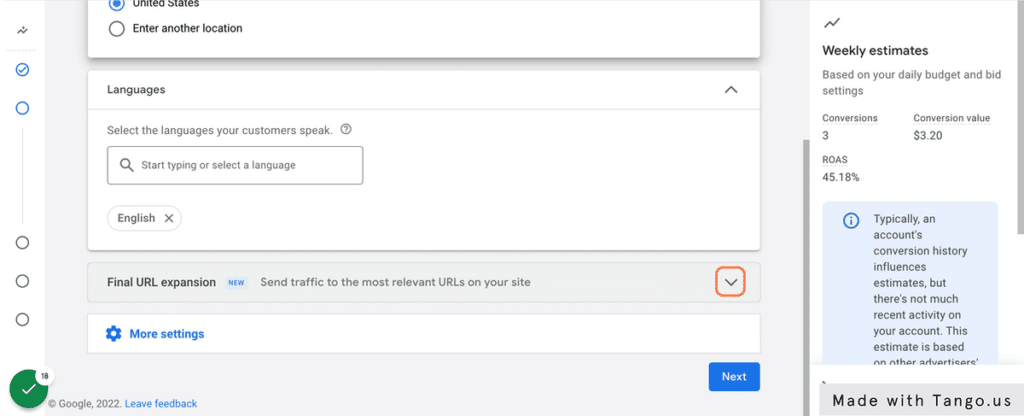The marketing world requires efficiency and reach to convert leads into customers. The Performance Max is Google’s solution to a common challenge: managing multiple campaigns across different platforms.
So, what’s the real-world advantage of using Performance Max?
This type of campaign is a one-stop-shop. Businesses can use Performance Max to cover all these platforms with a single campaign instead of setting up individual campaigns for Search, Display, YouTube, and Discover.
This saves time and ensures consistent messaging across channels and other benefits discussed later.
For businesses, this means a more streamlined advertising process, reduced management overhead, and the potential for a higher return on investment. By targeting customers across multiple touchpoints, the chances of conversions increase.
This article focuses on what Performance Max is for Google ads. We’ll explain its features, benefits, and how to build a campaign with optimal bid and budget. We’ve also covered this topic in one of our articles: Create Performance Max Campaigns Google Ads.
- Performance Max Definition
- How Do Performance Max Campaigns Work?
- Performance Max Features
- Benefits of Using Performance Max Campaigns
- Cons of Performance Max Campaigns
- Single Performance Max Campaign Report
- How to Build a Performance Max
- When to Maximize Campaign Performance
- 10 Tips to Succeed with Performance Max Campaigns
- The Performance Max Checklist
- GamerSEO Maximizes Your Ad Results
Performance Max Definition
The performance max is an automated campaign (Smart Bidding) that focuses on the business goals and allows you to use the entire Google Ads inventory from a single campaign.
You can complement your search campaigns with it and find more customers using all of Google’s advertising channels like:
- Youtube.
- Display.
- Search.
- Discover.
- Gmail.
- Maps.
Performance Max helps Google Ads campaigns to drive specific goals. You should target ROAS and lower CPA to improve conversion value.
It combines AI tech and ensures the ad attributes are optimized. This includes:
- Audience signals.
- Creative assets.
- Ad copy.
- Attributes.
- Budget optimization.
- Bidding strategy.
A Performance Max campaign intends to prioritize single campaigns through all Google platforms.

How Do Performance Max Campaigns Work?
A Performance Max campaign does multiple things at the same time.
It combines four types of campaigns (search, shopping, display, and YouTube) while also using smart shopping and dynamic search ads. You can also perform smart shopping upgrade to performance max.
You must link Google Ads with the Google Merchant Center Feed to visualize assets like headlines, videos, and images. With all this, Google works to create a Performance Max and multiple asset groups to improve your campaigns and overall performance.
Google Performance Max works differently than Smart Campaign, for example. If you wonder what are the differences between the two, you can check our performance max vs smart campaign comparison.
Performance Max Features
When you run Performance Max campaigns, you access seven features on your Google Ads account.
Let’s break them down:
Bidding & Budgeting
A Performance Max in a Google Ads campaign allows you to choose how to work on your bids and control your budget.
This means you can leverage your options and use max conversions, max value, max CPA, and similar attributes to maximize your efforts on your marketing objectives.
Location Adjustment
This type of ad allows you to choose where you want your ads to show. This way, if you have local campaigns, you can ensure you show them in the city or country where your business operates.
You can then select run dates and languages and prepare an ad schedule.
Advanced URL
URLs are essential for all sorts of ads, they are the place where you want people to go. So, you can use the Advanced URL function to choose the web page your ad will use as the final URL.
If you don’t decide your page, Google will do it for you.
Ad Groups
The ad groups have similar attributes and can be shown in display campaigns or other assets.
Depending on your goals, you can create as many groups as you want.

Automated Targeting
Select audiences that give Google insights about who your target is. The browser understands that your ads will show automatically to those more likely to convert. However, adding audience signals can help increase online sales and other conversions.
This data provides insights about consumers, including behaviors and interests, that increase performance campaigns.
Existing search campaigns have one target. So, consider doing a benchmark or target research before launching your ads.
Ad Extensions
The ad extensions show extra information about your business in the SERPs. You can use existing ones or create new formats for your ads.
Still, Google suggests extensions based on your goals. These include:
- Snippets.
- Price.
- Promotions.
- Callouts.
- Phone numbers.
Here’s an example. Let’s say you’re preparing discovery campaigns where you have A/B tests to see which one has better lead generation and overall performance. You can set up different extensions for each and see which ones work better.
Benefits of Using Performance Max Campaigns
PMax campaigns have five clear benefits that take advantage of all of Google’s tool repertory for the best results.
More Visibility
Performance Max allows your campaigns to use Google’s Machine Learning to optimize your results automatically using all the ads properties.
This way, you can reach your search campaign max potential and find customers using a single point.
Multiple Targeting Aspects
When using Performance Max, you can use multiple target aspects to increase customer acquisition.
As Google uses real-time consumer preferences and search intent data, you can use PMax to unlock customer segments you haven’t found yet.
To use all the ads’ potential, you can use the following signals:
- Affinity: You can segment your audience into groups that share the same interests and topics. For example, groups of dog lovers.
- Live situations: These customers pass through crucial events and will likely purchase your products.
- Market: Targets customers that recently searched your products or similar and are interested in buying them.
- Current audience: These are people that are part of your current customer base
- Similar audience: Google uses AI to determine people with similar tastes that are likely to purchase, but you haven’t considered.
- Demographics: Filter audiences according to sex, gender, age, location, income, status, education, etc.
Extreme Efficiency
The Performance Max ads exponentially increase the ad efficiency and your budget. This is achieved thanks to the automated ad scheduling algorithm and the bidding strategies.
Google will automatically determine where the money should go for the best impact. This means that to Performance Max your ad spend, your money is allocated for conversion goals and nothing else.

Algorithmic Optimization
Google uses the Performance Max setting to optimize all the creative parts of your ad, including:
- Headlines.
- Descriptions.
- Images.
- Videos.
- Other campaign settings.
You can iterate combinations and find the best one for engagement or conversions.
A good asset mix will have all the Google Ads best practices for better results.
Improved Search Performance
The best aspect of Performance Max is that you can use existing search campaigns and modify them to find better opportunities and slots where you could be lacking optimization and losing clients.
So, you can use keyword-based search campaigns to increase your reach and boost conversions.
Cons of Performance Max Campaigns
But not everything is good news.
This advertising also has drawbacks you must consider before applying it to your business.
No Insights
Compared to other campaigns, like smart shopping ads, the Performance Max Campaigns don’t provide concise information about how the budget is allocated.
You could potentially have two results: either it goes extremely well, or you lose all your budget in maximizing results. Therefore, it’s crucial to work with what you have, in this case: learn how to use performance max reporting.
Campaign Cannibalization
Performance Max could involve multiple ads simultaneously, provoking keyword and ad cannibalization.
This happens when two or more advertising campaigns or terms compete to appear to your audience, provoking underperformance.
So, as the advertiser, you must ensure you understand how the PMax works for new customer acquisition or for whatever your goal is.
Lack of Information About Placements
You may be used to getting information about how your ads perform. But with the PMax, you only get how many impressions you had and where your business is showing.
It doesn’t provide insights about ad formats, landing pages, etc.
Single Performance Max Campaign Report
We know that Google’s Performance Max campaigns don’t provide much information.
But how can they help you?
Here’s a table that allows you to understand how the PMax automated campaign type enhances your ads performance:
| You can | You can’t |
| Report overall ad performance as a whole. | Report each asset group (ad group) separated. |
| Show location performance and results from responsive ads or branched search advertising. | Give information about targeting. |
| Express results in days, weeks or combined. | Add exclusions for your ads. |
| Add multiple ad groups. | Report on device performance. |
As you can see, while this is a way to grow your business fast, Performance Max works in a way that doesn’t allow you to obtain solid data to make improvements in your ads.
How to Build a Performance Max
Here’s how to optimize Performance Max campaign from scratch to get more conversions:
Establish a New Campaign With Clear Goals
Enter your Google Ads account, go to campaigns, and choose the option to create a new campaign.
Pick the campaign’s target and then pick the Maximum Performance type. You can find this option with the branded search, discovery, video, or shopping campaigns.

Allocate a Budget and a Bidding Strategy
Go to the budget and bidding section to determine your average daily budget and how you want to spend the allocated money in the Pmax campaigns.
You have two bidding options:
- Set a target cost per action. This will make the campaign reach an established CPA.
- Target ROI. This provokes the campaign to meet the target ROAS.
Note: Google suggests using a budget 3x the CPA to find new customers.

Include Location and Languages
Go to the Campaign settings and modify your ad’s location. Here, you’ll select where your ad will appear and exclude unnecessary places.
You can also modify the Language section to determine the ad’s dialect. You should pick multiple languages if you sell your product worldwide.
You could also modify ad scheduling and the campaign or final URL expansion in this section.

Build a Resource Group
This resource group is necessary for your PMax ad campaign. This includes:
- Image assets.
- Logos.
- Titles.
- Videos.
- Indicators.
They will work for a single campaign and automatically combine to maximize conversions and engagement. Some resources are more important than others. For example, Performance Max Google Ads Video is where you should put more effort. Here’s an example of how the resource group might look like:
| Resource Recommendations | Description |
| Images | 20 images. |
| Videos | 10 logos. |
| Audios | 5 audios. |
| Videos | 7 videos. |
| Titles | 5 short titles of up to 30 characters and 5 long titles of 100 characters. |
| Descriptions | Ad description of up to 60 characters. |
| CTAs | Various CTAs that convert. |
| URL options | URLs where you want to redirect. |
Add the Extensions
Choose which extensions will work better for conversion actions based on your goals. You can take Google’s recommendations or use others that have worked for you in the past.
Publish
Double-check with the Overview option to see if the PMax campaign follows your selected parameters.
If everything is “OK,” click publish!
When to Maximize Campaign Performance
Performance Max campaigns are great for those businesses who want to boost lead generation and wish to appear on every Google platform. But that’s not the only moment when you can apply PMax.
You can also do it when:
- You’re a small business and don’t have time to delve into strategy.
- You don’t have a large budget and don’t want to hire a PPC specialist.
Now, you must consider the lack of information you could get from using PMax. This is why some advertisers don’t like to use it unless the business is prepared to spend between $50 and $100 daily to gather information and learn how to work correctly.
10 Tips to Succeed with Performance Max Campaigns
Here are ten tips to improve your PMax results and ensure smooth ad performance.
Each of the below will provide clear value for your campaigns.
Prepare Funnel Conversion Tracking Mechanisms
PMax relies on automating bids and targeting. They work similarly to other ads like smart displays or local campaigns.
This is why conversion tracking should be your priority. This way, you can get richer insights and understand how the lead generation process works while determining lead quality.
Use them as a form of auto-generated reports that explain how your business develops using Performance Max campaigns.
Link PMax Ads with Google Analytics
You already know that PMax lacks reporting features. Here, you can find some tips on performance max reporting. But there’s one that you can use besides the landing page report to improve reporting transparency: Google Analytics.
You can link them up and gain deeper information about how ads interact with customers and how well your click-through rate performs.
For example, you can use Analytics to see if you need to add URL exclusions.
Beware of URL Expansion
PMax campaigns use different Google Ads simultaneously (Discover, Gmail, and Maps, among others.)
As such, you can use or deactivate the URL expansion feature. So, the ad has permission to send users to different landing pages instead of your final URL. This means you must ensure you have disabled the functionality before running your app unless you want that dynamism in your campaigns.
Include Videos in Your Resource Group
The Performance Max campaign is a creative-hungry product. That’s why having enough resources is important to take advantage of all of Google’s inventory.
Now, while in other campaigns, videos are optional, PMax requires these multimedia assets to ensure you express all you want to show to the audience. If you don’t do this, Google will create a generic video using the other components in your resource group.
Note: Your video must be on YouTube before you can use it.
Don’t Complicate with Locations
Google allows you to show your campaigns in two ways:
- Presence.
- Presence & Interest.
The first refers to users in a specific place, while the second includes what they like.
You should use Presence, as it will only show the ads across all of Google’s networks if the user is in your selected area. Otherwise, you could get lots of impressions but won’t increase conversions.
Hint: Use the Google Analytics combination to see which locations drive traffic.
Focus on Conversions
Compared to campaign types, PMax works for a specific advertising objective: Conversions.
They don’t work properly for other goals than conversion action. Still, if you want to explore how the assets perform, you could use a Page View conversion so the ad finds the best performance options that drive traffic.
Use Audience Segments and Signals
Audience signals are a feature reserved for PMax campaigns. With them, you show Google who your audience is interested in. This way, the platform will use the data as a starting point and branch out your signal to meet your expectations.
This is exactly how other conversion-focused campaigns work. So, if you’ve used them before, you won’t have a problem understanding this one.
Now, to establish the audience signal, you must consider two segments:
- Custom audience: List of custom terms that allow Google to find the right customers for you.
- Remarketing: List of customers that you want to reach out to again.
You can find all the customers’ data in the Audience Manager section.
Insights Tab for Improved Reports
We already know that Performance Max campaigns lack insights. However, you can solve this issue by going to the Insights tab.
You can check your campaign a few days after release to see the top-performing categories and audience segments.
The categories answer whether your PMax is focused on branded searches and if the campaign finds new search opportunities or targets the ones you have already selected.
Use Your Google Merchant Center Feed
The Performance Max ads use the same assets when you connect the Google Merchant Center Feed.
So, ensure you have your campaigns connected to the merchant and don’t duplicate content.
To improve your ads, you could add real-life images and videos showing how your product works. This will increase authority according to Google’s guidelines.
Now, when including this type of content in your resource group, consider the following:
- Keep minimal text.
- Show authentic images, don’t use stock pictures.
- Highlight one focal point.
- Use people in your images.
The Performance Max Checklist
We recommend you use a checklist to ensure you have everything needed to develop your Performance Max campaigns.
The information below comes straight from the Google Shopping team and is meant to give insights about what is important to consider when using this impacting-performance tool.
Budget and bidding
- Start with a 30-day spend budget.
- Don’t limit your campaign to budget alone.
- Optimize the bidding strategy to maximize results.
- Use Maximize Conversion
- Use Maximize Conversion Value
Campaign settings
- Enable Final URL Expansion.
- Develop headlines that match the landing page content.
- Align the Country of Sale option in both feed match and campaign.
Asset groups
- Start with an asset group with content related to a single theme.
- [optional] Create different asset groups for a single campaign.
- Review the content to see if you comply with Google Ads ad criteria.
- [optional] Use the Self-Service Appeals to ask for disapprovals.
- Organize listing groups according to the Merchant Center information.
- Add as many assets as necessary to improve the people’s search.
- Upload a 10-second video asset.
Audience signals
- Use audience signals to improve machine learning and targeting.
- Prepare your own data segments to retarget customers.
- Enable custom data segments to find the best audience for your ads.
- Use audience signals with data that shows people that are likely to convert.
- Include higher intents and more specific audiences.
Ad extensions & Account level settings
- Use relevant extensions according to business goals.
- Make security adjustments on your account settings.
- Align your business goals throughout all campaigns.
- Add necessary exclusions.
GamerSEO Maximizes Your Ad Results
Performance Max Google Ads is a tool designed for businesses seeking efficiency in their digital advertising efforts. Centralizing campaigns across multiple platforms reduces administrative overhead and offers a more cohesive advertising strategy.
This is an investment that streamlines operations and potentiates higher returns. They become indispensable for business competition in a free market. So, ensure you use them to maximize your advertising ROI.
GamerSEO knows how hard this may be and the risks of doing it wrong. That’s why we have specialized staff focusing on leading your business in the right direction. We work towards increasing your brand awareness, conversions, and online authority while using different channels to diversify your marketing efforts.
Contact us to learn more!

A PPC specialist who started with organic social media. For several years, the core of his activities are:- Google Ads, Microsoft Ads, Meta Ads, TikTok Ads, Twitter Ads, Linkedin Ads. He has led campaigns with a global reach, e.g. for FootballTeam, G2A, ETOTO, as well as many smaller campaigns in the sports, construction and financial industries. Has full focus on ROAS. Privately, a fan of football, history of wars and Star Wars.

